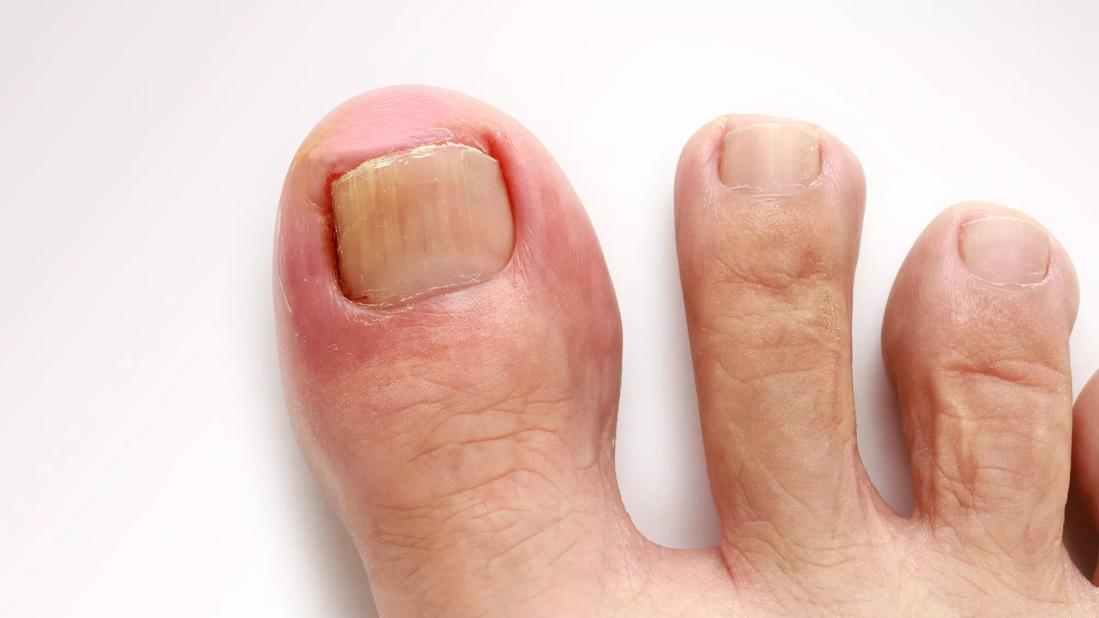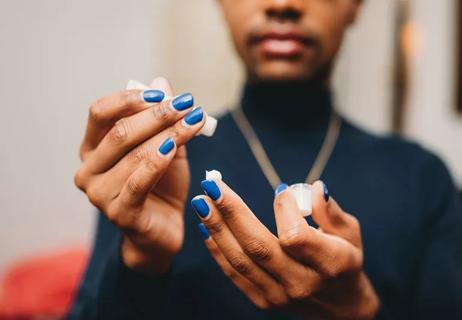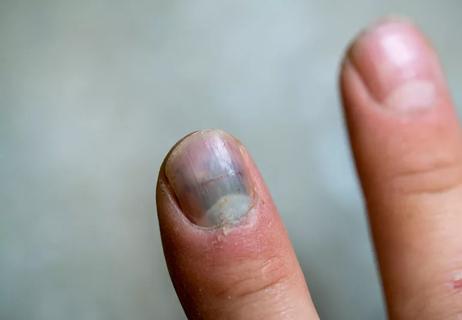Pain meds, toenail protectors and petrolatum jelly may spare you a trip to a podiatrist

If you’ve never had an ingrown toenail, consider yourself lucky. The condition is quite common. In fact, 2 out of every 10 people who see their healthcare provider for a foot issue are dealing with an ingrown toenail.
Advertisement
Cleveland Clinic is a non-profit academic medical center. Advertising on our site helps support our mission. We do not endorse non-Cleveland Clinic products or services. Policy
But what exactly is an ingrown toenail and why does it account for so many foot-related doctor visits?
Basically, it’s when the side edge of your toenail grows into the skin. The pressure that builds up will make you painfully aware of your toe. If left unaddressed, the nail will continue to dig into the skin causing way more pain than you’d think toes have any right to.
Ingrown toenails are annoying and inconvenient, but they normally heal on their own without causing long-term problems. But in some circumstances, for some people, these injuries can become serious.
“If an ingrown toenail causes a break in the skin, bacteria can enter and cause an infection, which will make it even more painful,” says podiatrist Georgeanne Botek, DPM.
We asked Dr. Botek to share her advice for addressing ingrown toenails at home. She offers several popular remedies that can make your tender tootsie a thing of the past. Equally important, she explains when and why it might be necessary to take your toe to the doctor for professional treatment.
If you’re ready to dip your toe into some home remedies, read on!
This option isn’t for everybody or every ingrown toenail, but for minor cases, it’s possible to nip the problem in the bud.
Advertisement
“First, soak your feet in a warm bath with Epsom salts or soapy sudsy water. This softens the skin and reduces inflammation and discomfort. Then, using clean nail-cutting tools, you can try to clip the affected area and apply antibiotic ointment. Applying a petroleum gel or antibiotic ointment with the first sign of pain or redness can give you good relief of pain and thwart infection,” instructs Dr. Botek.
If your attempt at a quick fix fails, swallow your pride and see a podiatrist. They have the equipment and experience needed to finish the job — and they don’t have to twist themselves into a pretzel to do it!
Dr. Botek suggests soaking the affected toe in warm water with Epsom salt or a mild soap for 10 to 20 minutes a day. Make sure you dry your toe thoroughly with a clean towel afterward to prevent infection. Once it’s completely dry, apply either antibiotic or petrolatum ointment and (loosely) bandage your toe.
Apple cider vinegar (ACV) soaks are also a popular option. That’s because ACV contains acetic acid, which can kill harmful bacteria. But be careful about how much you’re using. A quarter of a cup of the stuff diluted in a basin of warm water is plenty. We’re serious: Besides making your foot smell like a salad, using ACV by itself could burn your already-damaged skin.
Putting an occlusive ointment on your ingrown toenail will provide extra protection and help prevent infection.
Your best bet is petrolatum jelly. It’s just as effective as the most popular over-the-counter antibiotic ointments but doesn’t contain ingredients that can cause allergic reactions. If you do opt to use an antibiotic ointment, make sure you use one that you know you aren’t allergic to. You don’t want to deal with contact dermatitis on top of a painful ingrown toenail.
Crowding your feet into socks and shoes that are too short or tight can set up an environment for painful ingrown toenails to develop. This is why adolescents and teens often get them.
“Due to sudden growth spurts and body changes, teens and adolescents may outgrow their footwear quickly and can end up wearing them a while before buying better-fitting shoes,” Dr. Botek says.
While treating an ingrown toenail, wear sandals or open-toed footwear whenever you can. If you have to wear close-toed shoes, that’s OK. Just make sure you’re able to wiggle your toes easily in them. It might not be quite as comfortable as letting your little piggies roam free, but at least you don’t have to worry about stubbing your toe while it’s healing!
Advertisement
If you hit up your local drug store or your online retailer of choice, you’ll notice that there are a lot of products out there to keep your toes safe while they heal. Toe protectors, toe braces, toe sleeves, toe wraps, toe caps … the list goes on. There are even medicated options that soften the nail, making it easier (and less painful) to remove. They may or may not make the recovery process a little easier on you.
Ingrown toenail correctors and correction procedures, on the other hand … er … foot, are a bit more controversial. Some claim that this approach can help your nail grow above the edge of your skin. The procedure is simple:
It’s a popular approach to dealing with ingrown toenails; in fact, it’s something many providers will do for you during an appointment. But the American College of Foot and Ankle Surgeons says of the practice: “Not only does this not relieve the pain, it provides a place for harmful bacteria to grow, resulting in infection.”
“If you’re considering a DIY toenail correction, talk to your provider first,” Dr. Botek advises. “Whether it’s a good option for you depends on a number of factors, including your health history. When it comes to dealing with ingrown toenails, one size doesn’t fit all.”
Advertisement
We’ve gone over the things you should definitely do and the things you might consider doing for that ingrown toenail of yours. Now, let’s go over some of the things you definitely shouldn’t do:
A little bit of TLC often goes a long way with ingrown toenails. But home remedies aren’t always enough. It’s important to know when the time for DIY solutions is over. Here are a few good reasons to put on your open-toed shoes and walk/hobble into your healthcare provider’s office.
Advertisement
If you’ve tried taking care of your ingrown toenail yourself and it’s not improved (or has gotten worse), it’s time to get medical attention.
“You may need a minor procedure,” Dr. Botek says. “But even if you don’t, we have more sophisticated tools for dealing with ingrown toenails than you have at home — and our tools are properly sterilized.”
If you aren’t sure you can deal with treating your ingrown toenail at home, a podiatrist can do it for you using local anesthetic.
“In the office, we can cut out the offending nail border after first numbing the area,” Dr. Botek says. This helps the pain and allows the infection to heal but may not keep it from happening again.
Never ignore an infected ingrown nail. A prolonged infection can spread and lead to serious complications. Contact a healthcare provider if your toe is:
When in doubt, Dr. Botek says that it’s better to be safe than sorry. That’s especially true if you have any medical conditions that raise your risk of complications.
Dr. Botek advises skipping the home remedies and going straight to your provider if you have:
“Any medical condition that makes it harder to know that your toe is infected, harder to care for it or harder to perceive pain raises your risk of serious complications,” Dr. Botek states.
Despite your best efforts, you may just be more prone to ingrown nails than the average person. Maybe it’s the shape of your toes. Maybe it’s because you love long-distance running. Maybe you just enjoy showing off your sky-high heels, no matter how much they dig into your dogs.
The why isn’t important. What matters is that your toes are hurting on a regular basis. And they don’t have to.
For frequent ingrown nails, your provider may suggest a common office procedure called a matrixectomy.
“During a matrixectomy, the doctor numbs the region and removes the problematic nail portion. A chemical called phenol is then applied to burn and kill the cells that form the nail,” Dr. Botek explains. This offers a more permanent solution to recurring ingrown nails, saving time and sparing pain.
Ingrown toenails are common problems that usually resolve on their own. When they don’t, many people treat them at home without much trouble. From warm water and petrolatum jelly to over-the-counter pain relievers and apple cider vinegar, most of the things you need to take care of a gnarly nail are sitting in your fridge or a nearby cabinet.
While home remedies are pretty convenient — and often effective — they aren’t the best choice for everybody. If you’ve been struggling with ingrown toenails frequently (or have a medical condition that raises your risk of infection), skip the DIY treatments and make an appointment with a podiatrist. They can offer you a wide range of options for addressing the issue, from a quick in-office removal procedure to something more permanent.
Learn more about our editorial process.
Advertisement

Lunulae are the visible part of your nail matrix and typically carry very little cause for concern

This common problem has plenty of solutions, from supplements to slugging

Nail injuries need special care

Plus, ways to keep your bones healthy and strong!

Bone health starts with proper nutrition, exercise and healthy lifestyle choices

Some things you find in your house have antifungal properties — but that doesn’t mean they’ll clear your toenail fungus

Home remedies are unlikely to cure your contagious foot fungus — and they might even make it worse

Cramps can creep up if your shoes are too tight, you’re dehydrated or you have poor circulation

If you’re feeling short of breath, sleep can be tough — propping yourself up or sleeping on your side may help

If you fear the unknown or find yourself needing reassurance often, you may identify with this attachment style

If you’re looking to boost your gut health, it’s better to get fiber from whole foods